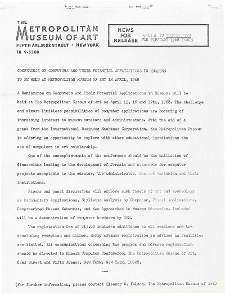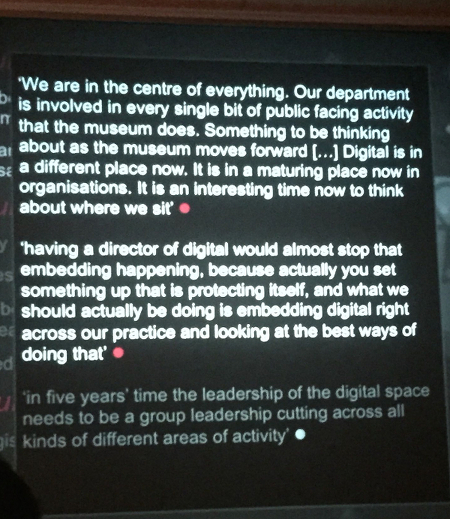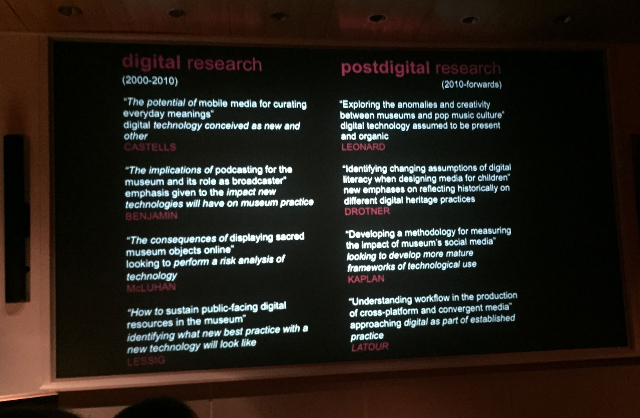Back to the Future
Ross Parry: The Postdigital Museum
Wednesday, January 28, 2015
Bard Graduate Center: Decorative Arts, Design History, Material Culture, New York

Press release from the Metropolitan Museum of Art for its “Conference on Computers and Their Potential Applications in Museums”
In April 1968, the Metropolitan Museum of Art in New York brought together museum professionals, academics, and computer technologists from IBM for a “Conference on Computers and Their Potential Applications in Museums.”1 A postconference report,” said Ross Parry, senior lecturer and college academic director in the School of Museum Studies at the University of Leicester, indicated that participants and attendees imagined their technological future in the year 1980. They envisioned a computerized image-search database that would allow a person to pull up any artwork that depicted, for example, “sailing vessels,” or to get information on objects in storage or from other museums. “This was reverie,” said Parry, of these predictions for a digital institution. In 2015 museums have websites, mobile apps, collections databases, email newsletters, games, and myriad forms of communication that facilitate scholarly and professional exchange. “This moment,” Parry stated the obvious, “has arrived.”
Parry’s current research investigates the tipping point for digital technology in museums, when it evolved from being considered new, different, and even fearsome, to the present, when “it becomes a natural characteristic of the institution.” Whereas curators once conceived the digital aspects of an exhibition much later in their working process, these features are now created concurrently. “The digital creatives are in the room at the beginning,” Parry said. “They’re part of the ideation moment.” From the advanced skill sets of museum staffers and higher expectations from audiences to profound changes in fundamental approaches to design and education, the museum has entered a postdigital phase.
At the outset of his talk Parry sought to legitimize the term “postdigital,” which he intends to be an economical and precise description of our current moment—just after the digital revolution—and not just a toe-curling neologism. I can accept his designation without resistance, but his explanation about the differences between digital and postdigital being as clear cut as the distinctions between structuralism and poststructuralism, or between modernity and postmodernity, was perplexing, since folks are still debating these divisions. And apparently he’s unfamiliar with the postinternet art debates.
Technology in museums has become normative, a concept Parry borrowed from political theory and from business and management studies.2 In this context, he explained, normativity refers to shared work ethics and company values—it is considered a positive trait. With frameworks borrowed from disciplines outside museum studies, he can explicate the structures of domination (mission and values, policy and protocols, organizational shape), structures of legitimization (validated behavior and language, allocation of resources, valued skill sets), and structures of signification (strategy, brand) as the prism for analyzing an institution.

Leaders of digital departments in UK museums consider their future and their possible obsolescence (photograph by Christopher Howard)
While this theoretical background was formally dry, the implications are consequential, especially regarding organizational structuring and people’s jobs. For example, Parry traced digital development in museums: the IT departments that once maintained infrastructure evolved into new-media departments, which grew into teams to build websites and gallery-based features, working alongside the marketing and education departments, among others. Postdigital museums, Parry predicted, will eventually phase out new-media departments because digital activities will be embedded across the museum, in every department. The need for a standalone branch of an institution, a silo to defend, will eventually fade.
Parry has evidenced the postdigital notion not only through conversations with senior staffers in UK museums but also by scanning job titles in job classifieds. A museum at the digital level might seek to fill a web-designer position, but postdigital museums are searching for digital participation officers, online shop managers, digital marketing officers, and digital learning managers. Moreover, Parry suggested that a postdigital museum won’t need a director to lead a digital strategy; it will instead plan for its traditional roles of engagement, collecting, and exhibiting, which may or may not use digital technology. He also floated the notion that museum staff will work “permanently in beta,” meaning a project is launched, monitored, and constantly tweaked to the extent that, six or twelve months down the line, it will have mutated significantly from the initial public iteration. Goals are regularly redefined and may never actually be reached—something museum workers might find exciting, frightful, or both.
The distinction between online and offline experiences for audiences has collapsed, Parry argued. A geographically based mobile app for New York architecture isn’t a singularly digital experience, he said, because the user is on the streets, with the sights, sounds, and smells of the city surrounding the person. A museum visitor might use his or her smartphone in tandem with looking at an object, and people walking through a park might receive historical sound clips on their phones relayed from iBeacons. Such hypothetical examples provide “an incredibly visceral, sensual, embodied experience” for the postdigital viewer. Because of resources, cultural context, and professional skill sets, Parry said, not every museum needs to be postdigital. Indeed, I wondered how institutions that are still resistant to digital, that have a poorly developed digital presence, or that—worst of all—lack a sufficient understanding of the importance of digital technology can survive in a postdigital world. Because technology advances rapidly, negligent, clueless, or impoverished organizations may fall too far behind and flirt with irrelevance.

Ross Parry noted the shift in PhD research toward postdigital topics (photograph by Christopher Howard)
A man in the audience asked if digital technology augments human experience, or if it’s incorporated into a person’s full sense of being. “Which impulse is stronger?” he wanted to know. Digital, Parry responded, “has a profound ontological effect” on the way we perceive the world, shaping our community and our expression. He is fond of Lev Manovich’s observation, from 1999, that the database is the symbolic form for our time, just like linear perspective was a way of conceiving knowledge in the Renaissance, as the art historian Erwin Panofsky argued in 1927.3
One audience member asked about remediation for media, and another questioned the politics of access and disenfranchisement. Parry flipped the question, wanting to consider the consequences of people using digital devices more and more but noticing this behavior less and less. One attendee raised the old “challenge to curatorial authority” chestnut, seemingly incapable of accepting that a populist interpretative experience can coexist with the sovereignty of the anointed expert. Then I realized how few people understand that artists are often the ones who challenge curators and institutions—and even challenge the idea of what art is—with the greatest amount of success.
In Terms Of count: 5.
1For a review of the published conference proceedings, see Edward F. Fry, “The Computer in the Museum,” Computers and the Humanities 4, no. 5 (May 1970): 358–61.
2One example he gave was James Barham, “Normativity, Agency, and Life,” Studies in History and Philosophy of Science Part C 43, no. 1 (March 2012): 92–103.
3See Lev Manovich, “Database as Symbolic Form,” Convergence: The International Journal of Research into New Media Technologies 5, no. 2 (June 1999): 80–99; and Erwin Panofsky, Perspective as Symbolic Form, trans. Christopher Wood (New York: Zone Books, 1991).
Watch


